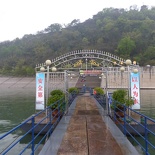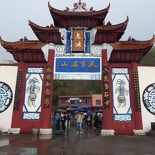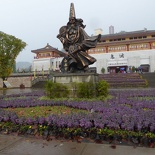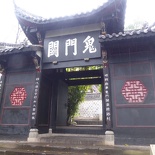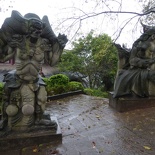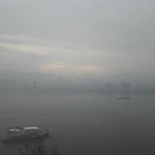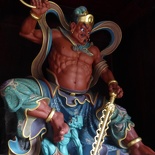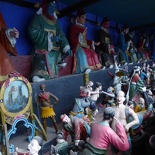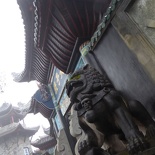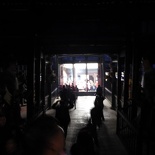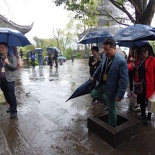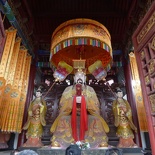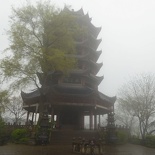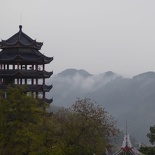Fengdu Ghost City (Fēngdū Guǐ Chéng) is an attraction consisting of shrines, temples and monasteries dedicated to the afterlife. Located in Fengdu County on the Ming mountain 170km downstream (West to east) from Chongqing municipality on the Yangtze River north bank, the site is largely accessible via road or docked on the ship piers along the Yangtze River.
The visit to the ghost city starts off from the river at water level and via climbing stairs up the hill. After completion of the Three Gorges Dam, the rising upstream river water levels separated the ghost city attraction from the city of Fengdu, which was rebuilt on the Yangtze south side higher up the mountainside. Most of the buildings on-site were restored from the original buildings- still retaining the traditional architectures. The city consists of structures, dioramas, and statues related to Diyu.
The idea of a hell “ghost city” is refreshing and very interesting, it is surprising the subject is not something most people will relate to as a subject of taboo. You get to pass through the “Hell gates”, and understand concepts of the underworld and hell (or Naraka) in Chinese mythology and Buddhism. Many of the temples and shrines show paintings and sculptures of people being tortured in the afterlife for their sins. The site’s history goes back nearly two thousand years, in legends, focusing on the afterlife and combines the beliefs of Confucianism, Taoism, and Buddhism. The architecture of the temples is typically that of the early Qing dynasty period, modelled to resemble Youdu, the capital of Diyu. The structures stood the test of time and existing till today, even the nicely hand-painted statues in the temples were all intricately preserved.
According to legend, Fengdu got its name of “Ghost city” during the Eastern Han Dynasty. The combination of two imperial official names, (Yin Changsheng and Wang Fangping) who came to the Ming mountain to practice Taoism (and became immortals) yielded “Yinwan”, meaning “King of Hell” setting the city’s focus on the underworld. The city had some popular mention in several classic Chinese works of literature like Journey to the West, Apotheosis of Heroes, and Strange Stories from a Chinese Studio. Near the top of the hill is Tianzi Palace, the largest and being over three hundred years old, and is the oldest building on the grounds.
- Bridge of Helplessness
Every soul has to cross “The Bridge of Helplessness” before entering the underworld. This stone bridge was built during the Ming Dynasty, it is a test for Good and Evil. It has three arches, with the center bridge used for testing. The good are allowed to pass while the evil will be pushed to the water below. The spot is a tourist attraction and a popular paid photography spot now. - Ghost-Torturing Pass
The dead present themselves for judgment before Yama, King of Hell here. This hall is lined with intricately detailed painted large sculptures of demons along the sides leading up to Yama in a dimly-lit temple with huge doors and high step-in. - One leg stand at Tianzi Palace
In the third and final test, the dead must stand on a stone at the entrance to Tianzi Palace on one foot for three minutes. Legend says that a virtuous person will be able to do it while an evil person will fail and be condemned to hell.
However, not many of the buildings on the site stood the test of time, many in the compound are either upgraded and not original. One such visible tell-tale sign is the mixed use of structural concrete for more recent modern buildings additions to the site instead of wood. Last but not least, at the top of the Ghost city past the Tianzi Palace is the Home Tower (or The Home Viewing Pavilion, 望乡台). Built in 1985, this more recent addition at the top of the Fengdu ghost city hill is a majestic 8 storey concrete pagoda perched over a cliff side overlooking the hills and farming terraces in the distance. Legend has it that every soul that passes by on their journey to the underworld can have one last look from here towards their home, families and loved ones in the world of the living. It can also get rather misty up here on the hills.
The Ghost city is a lesser attraction, good a for a 2 hour visit, though there is nothing much in terms of building architecture. I particularly liked the beauty of the hand crafted sculptures in the temples, as well as the views of the farmlands and the Yangtze at the top of the hill. I found that the constant misty fog up in the hills around the temples, gives the vicinity a rather nice eerie surreal feel, which adds to the atmosphere of the ghost city.
Catch more sights of the Fengdu ghost city in it’s photo gallery here.

